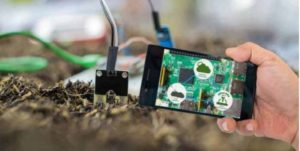How blockchain can be utilised in agriculture
 When I started exploring how blockchain technology and distributed ledgers over five years ago, one of the first use cases I envisioned was called ‘Field to Fork’.Whilst the rest of the world was thinking about how they could become millionaires from crypto-currency, I could see the power of blockchain would solve the issue of proof of provenance, amongst many other things, far beyond crypto.
When I started exploring how blockchain technology and distributed ledgers over five years ago, one of the first use cases I envisioned was called ‘Field to Fork’.Whilst the rest of the world was thinking about how they could become millionaires from crypto-currency, I could see the power of blockchain would solve the issue of proof of provenance, amongst many other things, far beyond crypto.
If it’s Columbian coffee, Manuka honey, genuine maple syrup or New Zealand lamb the principles are the same, proof of provenance is key and, the same rules apply to Prada handbags, Peruvian asparagus and yes, digital currency.
What is blockchain?
Firstly, let’s explore what, in essence, blockchain is.Blockchain or distributed ledger technology (DLT) is a technological protocol that enables data to be exchanged directly between different contracting parties within a network without the need for intermediaries. The network participants interact with encrypted identities(anonymously); each transaction is then added to an immutable transaction chain and distributed to all network nodes.
The ramifications of this technology are profound. Trust is key in any transaction. To take place a transaction requires the buyer to believe that the seller will deliver their goods or services. A transaction built around Blockchain removes any element of surprise. It’s thelack of surprises and the implicit trust that blockchain delivers that makes it so important for the agricultural industry.

Agriculture and provenance
I mentioned at the start of the piece some foods that rely on where they originate to drive their value. After all, honey, not called Manuka may taste different but why the high price? Blockchain can prove provenance really quite simply. Once a product is ‘made’ from a jar of honey, a leg of lamb, or a bottle of fine wine, that product is then listed on a blockchain. From the point of production to the point of sale, or consumption a cryptographically secure ‘key’ can track its journey and, ultimately, prove what is and where it comes from.
This key doesn’t need to be used for high-value foods whose place of origin is inherent to that products brands either (think Parmesan cheese), ‘fake food’ is becoming a problem, especially in places like China.
Blockchain and ‘best before’
With many products, especially fruit and vegetables,touch, taste, and smell will tell you how old it is. But,as agri-tech innovation increases, especially around prolonging the shelf life of food, blockchain could alsoensure the food we eat is fresh. It wouldn’t take a huge leap of faith to imagine a consumer walking around a supermarket with a smartphone, scanning a product via a 2D barcode linked to a blockchain and seeing not only where the goods came from but when it was produced and what journey it took — from field to fork.
The value of blockchain for the food producer
Logging the production and distribution of food on blockchain needn’t be only beneficial for the consumer, producers will benefit too. If we consider the fishing industry, most developed markets now place quotas on fishermen to protect stocks. With something as simple as a smartphone app the fisherman can log his catch. This ‘transaction’ is the logged on the blockchain and an immutable record is created. Another scenario might be a producer of Manuka Honey. If the producer logs each batch onto a blockchain and then sells to a wholesaler who then sells onto a distributor (a chain of supermarkets) he will be able to see which distribution channel performs the best and what his product retails for.Blockchain can afford instant business intelligence for the producer with total transparency.
 Total control and complete transparency
Total control and complete transparency
If you want to make a representation of a food product or commodity with certain characteristics and track that item in a supply chain, it is important that you cannot make copies of that item. Otherwise,one could,for example, claim that you sell the same Parmesan cheese by reusing the same digital identity over and over again.
If blockchain is embedded at the heart of the production and distribution process we can be sure there is no risk of copying and “double spending” or “double selling”. Each characteristic of the food such as certificates of fair trade or limited production cannot be duplicated or replicated.
A central database could, potentially, accomplish the same objective, but only if there is implicit trust in the owner of the database. On top of this factor, the parties being part of the supply chain and their actions will be public or known by those who can access the database,legitimately or by illegal means. This may not be good for competitive reasons and privacy. The distribution of goods contains sales figures that, are commercial in confidence.
Beyond Crypto
Bitcoin was the first to solve this ‘double-spending’ problem. There is no reason why the production of food can’t be the next industry to benefit from the transparency that blockchain offers.

Gary Spence, CEO Yotta Laboratories
© Yotta Laboratories 2018






